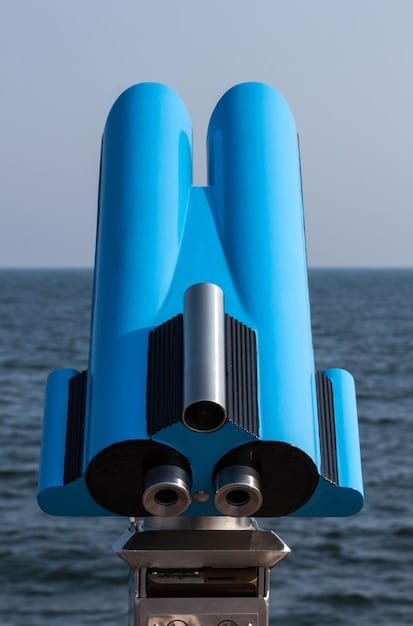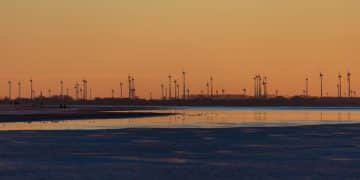Wave Energy Converters: US Pilot Projects & Future Potential

Exploring the Potential of Wave Energy Converters: Recent US Pilot Projects and Future Prospects involves harnessing ocean wave energy to generate electricity, with pilot projects demonstrating feasibility and future potential for large-scale renewable energy generation in the US.
The vast energy potential of ocean waves remains largely untapped, but the United States is making strides in exploring the potential of wave energy converters through recent US pilot projects and future prospects. This technology promises a clean, renewable energy source that could significantly contribute to the nation’s energy mix.
The Promise of Wave Energy
Wave energy represents a considerable source of clean, renewable power. Unlike solar and wind, wave energy is more consistent and predictable, offering a reliable alternative to fossil fuels.
Advantages of Wave Energy
Wave energy converters (WECs) can provide a consistent and predictable energy supply, making them an attractive option for coastal communities and island nations.
Challenges in Wave Energy Development
Despite its potential, wave energy faces several challenges, including high development costs, environmental concerns, and the need for robust technology that can withstand harsh marine conditions.
- Environmental Impact: Ensuring minimal disruption to marine ecosystems.
- Technology Durability: Building systems that survive in harsh ocean environments.
- Cost-Effectiveness: Reducing the overall cost to compete with other energy sources.
Wave energy stands as a promising renewable resource, though overcoming developmental obstacles remains a crucial step for widespread adoption.
Recent US Pilot Projects
Several pilot projects in the US are demonstrating the feasibility and potential of wave energy conversion. These projects are crucial for testing different WEC technologies and assessing their performance in real-world conditions.

Key Projects and Locations
Pilot projects have been implemented across various coastal regions of the US, including the Pacific Northwest and Hawaii. Each location presents unique wave conditions and environmental considerations.
Technology Showcase
These pilot projects serve to showcase different WEC technologies and provide valuable data on their efficiency, reliability, and environmental impact. Projects include:
- Oregon State University’s Wave Energy Test Site (WETS): A grid-connected open-water test facility.
- Northwest National Marine Renewable Energy Center (NNMREC): Focused on advancing marine renewable energy technologies.
- Hawaii’s Wave Energy Test Site (WETS): Testing different wave energy conversion technologies in real-world conditions.
US pilot projects are contributing important data about Wave Energy technology, and continue to improve feasibility and effectiveness.
Wave Energy Converter Technologies
Wave energy converters come in various forms, each designed to capture the energy of ocean waves in different ways. Understanding these technologies is essential for evaluating their potential and suitability for specific locations.
Oscillating Water Columns (OWC)
OWCs use the wave motion to compress air, which then drives a turbine to generate electricity. These systems are often deployed near shore or integrated into breakwaters.
Point Absorbers
Point absorbers are floating structures that move up and down with the waves, using this motion to drive a generator. They are typically deployed offshore and can be more efficient in certain wave conditions.
Overtopping Devices
Overtopping devices capture water as waves break over them, using the stored water to drive turbines. These systems can be integrated into coastal defenses, providing both energy generation and coastal protection.
Different types of wave energy converters offer unique advantages, each suited to specific environmental and operational conditions.
Environmental Considerations and Impact
The deployment of wave energy converters raises several environmental considerations. Careful planning and monitoring are essential to minimize potential impacts on marine ecosystems.

Potential Environmental Effects
Potential environmental effects from WECs include noise pollution, habitat disruption, and impacts on marine life. It is necessary to complete thorough environmental impact assessments to mitigate these effects.
Mitigation Strategies
Mitigation strategies include careful site selection, minimizing noise emissions, and monitoring the effects on marine organisms. Using echo sounders to temporarily drive away marine life during construction can also help.
Regulatory Framework
The regulatory framework for wave energy development in the US involves multiple agencies, including the Federal Energy Regulatory Commission (FERC) and the Environmental Protection Agency (EPA). Developers must obtain permits and comply with environmental regulations to ensure responsible deployment.
Environmental stewardship is a critical component of growing wave energy technologies and infrastructure to reduce any major disruptions to the natural world.
Economic Feasibility and Market Potential
The economic feasibility of wave energy depends on factors such as technology costs, energy prices, and government incentives. As technology improves and costs decrease, wave energy could become a more competitive energy source.
Cost Analysis
Cost analysis involves evaluating the capital costs, operating costs, and levelized cost of energy (LCOE) for wave energy projects. Reducing these costs is essential for attracting investment and making wave energy economically viable.
Market Opportunities
Market opportunities for wave energy include supplying power to coastal communities, powering offshore facilities, and contributing to the overall renewable energy mix. As demand for clean energy grows, the market potential for wave energy is expected to increase.
- Coastal Communities: Providing reliable and sustainable power.
- Offshore Facilities: Powering oil rigs, aquaculture farms, and research platforms.
- Grid Integration: Contributing to the overall renewable energy mix.
Wave energy’s competitive edge relies on decreasing production expenses and capitalizing on energy industry incentives.
Future Prospects and Innovations
The future of wave energy depends on continued innovation and investment in research and development. New technologies, materials, and deployment strategies could significantly improve the efficiency and cost-effectiveness of wave energy converters.
Technological Advancements
Technological advancements include developing more efficient and durable WEC designs, improving grid integration, and exploring new materials and manufacturing techniques. Continued innovation is essential for realizing the full potential of wave energy.
Policy and Investment
Supportive policies and investment in research and development are critical for advancing wave energy technology. Government incentives, tax credits, and research grants can help stimulate innovation and attract private sector investment.
- Government Incentives: Tax credits and subsidies to encourage wave energy development.
- Research Grants: Funding for research and development to improve WEC technology.
- Public-Private Partnerships: Collaboration between government, industry, and academia to advance wave energy.
The wave energy sector can continue to develop with the right financial backing, which would lead to more breakthroughs in the technology being used.
| Key Point | Brief Description |
|---|---|
| 🌊 Wave Energy Potential | Consistent and predictable renewable energy source. |
| 🧪 US Pilot Projects | Testing feasibility and performance of different WEC technologies. |
| 🛡️ Environmental Considerations | Mitigating noise, habitat disruption, and impacts on marine life. |
| 💰 Economic Feasibility | Achieving competitive costs and attracting investment. |
Frequently Asked Questions About Wave Energy
▼
A wave energy converter (WEC) is a device that transforms the kinetic energy of ocean waves into electricity. Different types of WECs exist, each capturing wave energy in unique ways to generate power.
▼
Wave energy projects in the US are primarily located in coastal regions with significant wave resources. Key sites include the Pacific Northwest (Oregon, Washington), Hawaii, and other coastal areas exploring marine energy.
▼
Wave energy has the potential to be highly efficient due to its consistent and predictable nature. However, current WEC technologies are still under development, and efficiency varies depending on the technology and location.
▼
The main environmental concerns include noise pollution, habitat disruption, and potential impacts on marine life. Careful site selection and mitigation strategies are essential to minimize these effects.
▼
The future prospects for wave energy are promising, with ongoing research and development aimed at improving WEC technology and reducing costs. Supportive policies and investment will be critical for realizing its full potential.
Conclusion
Exploring the potential of wave energy converters through recent US pilot projects and future prospects, it is evident that wave energy represents a significant opportunity for clean, renewable power generation. As technology advances and costs decrease, wave energy is poised to play a crucial role in the nation’s energy future, providing a reliable and sustainable alternative to fossil fuels.





